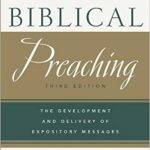Classification of sermons 4 – Robinson

In Biblical Preaching: The Development and Delivery of Expository Messages (3rd ed.), Haddon Robinson outlines the main forms, or shapes, that sermons can take.
Here’s a precis.
1. Deductive arrangements
The main idea is stated at the outset, and the body of the sermon explains, illustrates and applies that idea.
(a) An idea explained. For example, Alexander MacLaren preached a sermon on Colossians 1:15-18 on the supremacy of Christ, explaining from his text that Christ is so because he is ‘the image of the invisible God; because he is ‘the firstborn of all creation’; and because he is ‘the head of the body’.
(b) A proposition to be proved. A sermon from 1 Corinthians 15:12-19 might defend the proposition that ‘the Christian faith is worthless unless Christians rise from the dead.’ The argument develops: If Christians do not rise, the Christian faith lacks valid content, vv12-14; the apostles are liars, v15; the Christian faith is futile, v16f; and Christians have no hope, v18f.
(c) A principle to be applied. Preaching from 1 Peter 2:11-3:9 we might ask: What attitude should Christians have in a world that is unfriendly to the things of God? Answer: We are to be subject to every human institution for God’s sake, 2:11f, 21-25; this principle must govern all our social relationships, 2:13-20; 3:1-7.
2. Semi-inductive arrangements
(a) In one type of semi-inductive form, only the subject (not the complete idea) is stated in the introduction, and the main points complete this. In James S. Stewart’s exposition of Hebrews 12:22-25, the preacher begins by stating that his purpose is ‘to make us realize the riches of our heritage when we assemble in our places of worship.’ Development: our corporate worship is rich in that it is a spiritual fellowship, v22, a universal fellowship, v23, an immortal fellowship, v23, a divine fellowship, v23f, and a redeeming fellowship, v24.
(b) In the inductive-deductive sermon, the idea is stated somewhere in the body of the message. Such as sermon might explore a problem: first, by identifying it, exploring its roots, and examining inadequate solutions; second, by proposing, explaining, defending and applying a biblical solution to the problem. Such an arrangement fits ‘life-situation’ preaching well, and enables a bridge to be built between personal needs and scriptural truth.
3. Inductive arrangements
In the inductive sermon, the main idea is stated at the end, with each earlier point building towards it. The truth is not presented on a plate; rather, the listener shares in its discovery.
Inductive sermons can work with with hostile or indifferent audiences. Through induction a series of ideas can be presented, to each of which the hearer will respond with a ‘Yes’. These lead on to an idea to which she or he might previously have said, ‘No’, but is impelled to receive and affirm it. This was Peter’s procedure in Acts 2 – the main idea is found at the end – “Therefore let all the house of Israel know assuredly that God has made this Jesus, whom you crucified, both Lord and Christ” (Acts 2:36). If Peter had stated this at the outset, he might not have escaped with his life!
An inductive sermon has movements, rather than ‘points’. Something like this:
- Someone’s life is in a mess
- But look! This mess is part of something larger
- Actually, we are talking about a fundamental and universal aspect of human nature
- How did we get into this mess?
- What solutions have people tried to get themselves out of this mess?
- Finally: some good news! There is a way out of this mess!
The sermon is not so much a discourse as a conversation about real people and their lives, and how God’s word speaks into their problems, needs and experiences:
‘The difference between a religious discourse and a sermon throbbing with life is the difference between reading a book on poverty and standing in line with a mother and her three hungry kids waiting to get some food stamps. Share Paul’s fury as he wrote to the Galatians. Feel a knot in your stomach over Asaph’s faith-shaking doubts in Psalm 73. Smell the stench of Job’s sores. Experience Timothy’s anxiety in feeling overmatched and undermanned by his assignment at Ephesus.’
Inductive preaching connects well with people who are used to TV and movies.
‘We have become a storied culture. Whether it is a mystery drama, a comedy, or even a sports contest, there is a large element of induction. The drama isn’t solved until the end of the last act, and the joke leads up to the punch line, and the sports event moves toward the final score. Inductive sermons fit that way of thinking.’
For this reason the narrative sermon has become a particularly important type of inductive sermon. And, after all, the Bible itself is full of stories.
‘When Jesus appeared, he came telling stories, and most of them have entered the world’s folklore. In fact, so brilliant a storyteller was Jesus that we sometimes miss the profound theology disguised in his tales of a rebellious delinquent and his insufferable brother, a pious Pharisee and a repentant tax collector, buried treasures, and a merchant who had an unexpected appointment with death.’
No biblical story is, and no narrative sermon should be, merely a story. There is still a main idea. There are still other, supporting, ideas. But these are all woven into the fabric of the story itself. And these are best told, and best understood, by being told as part of the story, rather than being extracted out of it. The story should be told well enough to be self-explanatory.
Stanley Kubrick once said:
‘The essence of dramatic form is to let an idea come over people without its being plainly stated. When you say something directly, it is simply not as potent as it is when you allow people to discover it for themselves.’